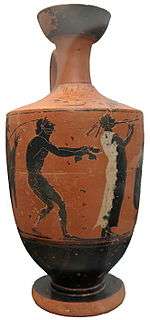Halteres (ancient Greece)
- This article concerns an ancient sports object. For halteres in insect anatomy, see Halteres.
Halteres (/hælˈtɪəriːz/; Greek: ἁλτῆρες,[1] from "ἅλλομαι" - hallomai, "leap, spring";[2] cf. "ἅλμα" - halma, "leaping"[3]) were a type of dumbbells used in Ancient Greece. In ancient Greek sports, halteres were used as lifting weights,[4][5] and also as weights in their version of the long jump,[6] which was probably a set of three jumps. Halteres were held in both hands to allow an athlete to jump a greater distance; they may have been dropped after the first or second jump. According to archaeological evidence, the athlete would swing the weights backwards and forwards just before take-off, thrust them forwards during take-off, and swing them backwards just before releasing them and landing. Halteres were made of stone or metal, and weighed between 2 and 9 kg (4 and 20 lb).
Writing in Nature, biophysicist Alberto E. Minetti calculates that halteres added about 17 cm (7 in) to a 3 m (10 ft) long jump.[7]
 Athlete holding halteres. Ancient Greek Attic black-figure lekythos, 525–500 BC, from Sicily. Staatliche Antikensammlungen, Munich.
Athlete holding halteres. Ancient Greek Attic black-figure lekythos, 525–500 BC, from Sicily. Staatliche Antikensammlungen, Munich. Young boy holding a discus at the palaestra. Near him, a pick to prepare the landing ground for the long jump and a pair of halteres used to maintain equilibrium during the jump. Interior of an Ancient Greek Attic red-figure kylix, 510–500 BC, Louvre Museum, Paris.
Young boy holding a discus at the palaestra. Near him, a pick to prepare the landing ground for the long jump and a pair of halteres used to maintain equilibrium during the jump. Interior of an Ancient Greek Attic red-figure kylix, 510–500 BC, Louvre Museum, Paris.
References
- ↑ ἁλτῆρες, Henry George Liddell, Robert Scott, A Greek-English Lexicon, on Perseus Digital Library
- ↑ ἅλλομαι, Henry George Liddell, Robert Scott, A Greek-English Lexicon, on Perseus Digital Library
- ↑ ἅλμα, Henry George Liddell, Robert Scott, A Greek-English Lexicon, on Perseus Digital Library
- ↑ Norman Gardiner, Athletics in the Ancient World, Dover, 2002, on Google books
- ↑ Bill Pearl, Getting Stronger: Weight Training for Sports, Shelter, 2005, on Google books
- ↑ Stephen G. Miller, Ancient Greek Athletics, Yale University Press, 2006, on Google books
- ↑ Minetti, Alberto E (14 November 2002). "Biomechanics: Halteres used in ancient Olympic long jump". Nature. 420: 141–142. doi:10.1038/420141a.